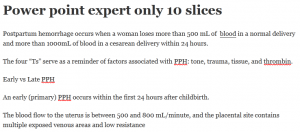Power point expert only 10 slices

Postpartum hemorrhage occurs when a woman loses more than 500 mL of blood in a normal delivery and more than 1000mL of blood in a cesarean delivery within 24 hours.
The four “Ts” serve as a reminder of factors associated with PPH: tone, trauma, tissue, and thrombin.
Early vs Late PPH
An early (primary) PPH occurs within the first 24 hours after childbirth.
The blood flow to the uterus is between 500 and 800 mL/minute, and the placental site contains multiple exposed venous areas and low resistance
A late (secondary) PPH occurs from 24 hours to 12 weeks after childbirth
Late PPH occurs in only 1% to 2% of all childbearing women, usually within the first 2 weeks after birth.
Retained placental fragments are the most common cause of late PPH.
A lack of uterine tone (atony) and genital tract trauma are the most common conditions that cause PPH
gns and Symptoms
nursing Diagnosis
eficient fluid volume related to excessive bleeding after birth.
Save all perineal pads used during bleeding and weigh them to determine the amount of blood loss.
Place the woman in a side lying position to make sure that no blood is pooling underneath her.
Assess lochia frequently to determine if the amount discharged is still within the normal limits.
Assess vital signs, especially the blood pressure